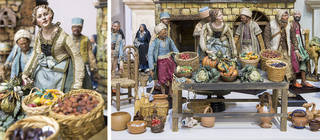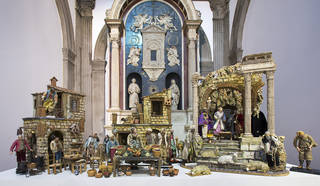From life-sized figures to intricate miniatures, Nativity scenes are popular around the world at Christmas time – but where does this tradition come from?
The custom of displaying a Nativity scene at Christmas began in 1223 when St Francis of Assisi is said to have staged the first recreation of the scene of Jesus' birth in the town of Greccio, Italy. This Nativity – known as a 'presepio' in Italian, after the Latin word for 'crib' – used living people and animals. Churches and homes across Europe soon began to stage their own versions with life-sized, moveable model figures or miniatures, in place of live participants.
In 18th-century Naples, renowned sculptors and painters were employed by aristocratic patrons, including the Neapolitan King, to create figures and backdrops for magnificent presepie. These tableaux were highly detailed and theatrical in design, incorporating not just biblical stories but vignettes of everyday life in Naples – street-sellers, beggars, market and town folk would rub shoulders with shepherds, the three Magi (Kings) and the holy family amid an architectural backdrop of taverns and ruined temples.
The V&A's collection of presepio figures and architectural scenery spans the 18th to the 20th centuries. It includes the traditional Christmas scenes of the Nativity, the Arrival of the Shepherds and the journey of the three Magi, surrounded by a tavern adorned with sausages and hams and a market laden with fruit and vegetables.


The main characters in the holy scene – Mary, Joseph and baby Jesus – are placed within ruined Roman columns, which, in the tradition of Italian Renaissance painting, symbolise the Christian church's replacement of pagan religions. The three Magi approach the group, their exotic appearance contrasting with the rustic shepherds, animals and beggars that crowd around. Traditionally, the figure of the baby Jesus is only placed in his crib at midnight on Christmas Eve.

The realistic tavern scene would have been quite recognisable to an 18th-century Neapolitan audience. It contains intricate details, like the sausages and hams hanging from the eaves and the building’s rustic brickwork, while Turkish musicians in colourful clothing mingle with locals seated outside. The bustling market scene is complete with food stalls piled with fruit, vegetables, fish and meats.

Miniature recreations of typical Italian markets like this are still created by Neapolitan craftspeople and sold from stalls near the church of San Gregorio Armeno in Naples at Christmas time.
The Nativity scene was on display in the magnificent surroundings of the Santa Chiara chapel, as part of Christmas at the V&A 2016.



